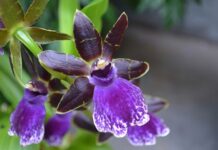Embark on a journey to elevate your African violet care skills with our comprehensive guide to mastering advanced techniques. In this article, we delve into a variety of topics designed to take your cultivation expertise to the next level. From exploring advanced propagation techniques such as air layering to embracing innovative water culture and semi-hydroponic growing methods, we’ll equip you with the knowledge and skills needed to propagate and nurture your African violets with confidence.
Air layering and other advanced propagation techniques
Dive into the realm of advanced propagation techniques for African violets and discover the secrets to expanding your collection with precision and expertise:
- Air Layering: Air layering involves creating a small incision in the stem of a healthy African violet, applying rooting hormone, wrapping the incision in moist sphagnum moss, and covering it with plastic to encourage root formation. Once roots have developed, the stem can be severed and planted as a new individual.
- Leaf Petiole Propagation: This technique involves removing a healthy leaf from an African violet, trimming the petiole to a specific length, and placing it in a rooting medium such as perlite or vermiculite. With proper humidity and care, new plantlets will emerge from the base of the petiole, eventually forming new plants.
- Tissue Culture: Tissue culture is a laboratory-based propagation method where small sections of tissue from an African violet are cultured in a nutrient-rich medium under sterile conditions. This technique allows for the rapid multiplication of plants and the production of genetically identical clones.
- Division: Division is a straightforward propagation method where a mature African violet plant is carefully divided into smaller sections, each containing roots and foliage. These sections can then be potted individually to create multiple new plants.
- Offset Propagation: Some African violet varieties produce offsets, or small plantlets, at the base of the main plant. These offsets can be carefully removed and potted separately to propagate new plants.
- Runners: Certain African violet varieties produce long, trailing runners that can be rooted in soil or water to create new plants. These runners can be encouraged to root by burying them in moist soil or placing them in a container of water until roots develop.
- Grafting: Grafting involves joining the stem of one African violet plant (the scion) onto the rootstock of another plant. This technique allows for the combination of desirable traits from different varieties and can be used to propagate rare or difficult-to-root cultivars.
Water culture and semi-hydroponic growing methods
Explore innovative cultivation methods for African violets that utilize water culture and semi-hydroponic growing techniques, offering precise control over moisture and nutrients:
- Water Culture: In water culture, African violets are grown in containers filled with a nutrient-rich water solution. The plant’s roots are submerged in the water, allowing them to absorb essential nutrients directly. Regular monitoring and replenishment of the water solution are necessary to maintain optimal growing conditions.
- Semi-Hydroponic Growing: Semi-hydroponic growing involves using a porous growing medium, such as LECA (Lightweight Expanded Clay Aggregate), to support African violet roots while providing access to water and nutrients. The growing medium wicks moisture up to the roots, promoting healthy growth and reducing the risk of overwatering.
- Hydroculture Systems: Hydroculture systems for African violets utilize a combination of water culture and semi-hydroponic growing methods, incorporating reservoirs or self-watering mechanisms to maintain consistent moisture levels. These systems offer convenience and efficiency, allowing growers to enjoy the benefits of hydroponic cultivation with minimal maintenance.
- Nutrient Solutions: Nutrient solutions formulated specifically for African violets are essential for water culture and semi-hydroponic growing. These solutions provide essential macronutrients and micronutrients in precise concentrations, ensuring optimal plant health and growth.
- Aeration: Proper aeration is crucial for water culture and semi-hydroponic systems to prevent root rot and promote healthy root development. Air stones or bubblers can be used to oxygenate the water and improve nutrient uptake.
- Monitoring pH and EC Levels: Regular monitoring of pH and EC (electrical conductivity) levels is necessary to ensure the proper balance of nutrients in the water solution. Adjustments may be needed to maintain optimal growing conditions and prevent nutrient imbalances.
- Transitioning from Soil: When transitioning African violets from soil-based cultivation to water culture or semi-hydroponic growing, gradual acclimation is essential to prevent shock and stress. Start by introducing the plants to a diluted nutrient solution and gradually increase the concentration over time as the plants adapt to their new growing environment.
Dealing with difficult or rare varieties
Navigating the care of difficult or rare African violet varieties requires patience, knowledge, and attention to detail. Here are some strategies to effectively manage these unique plants:
- Research and Understanding: Take the time to research the specific needs and requirements of the difficult or rare African violet variety in question. Understanding its native habitat, growth habits, and preferences will help you provide optimal care.
- Customized Growing Conditions: Tailor your growing conditions to match the natural environment of the plant as closely as possible. This may involve adjusting factors such as light levels, temperature, humidity, and soil composition to meet the plant’s specific needs.
- Observation and Monitoring: Regularly observe and monitor the difficult or rare African violet variety for signs of stress, disease, or nutrient deficiencies. Promptly address any issues that arise to prevent further damage and ensure the plant’s health and vitality.
- Trial and Error: Experiment with different cultivation techniques, watering schedules, and fertilization methods to determine what works best for the particular variety. Keep detailed records of your observations and adjustments to track progress and make informed decisions.
- Patience and Persistence: Be patient and persistent in your efforts to care for difficult or rare African violet varieties. It may take time to find the right balance of conditions and practices that enable the plant to thrive, but perseverance will ultimately lead to success.
- Networking and Support: Seek out advice and support from fellow African violet enthusiasts, breeders, or members of plant societies who may have experience with similar varieties. Sharing knowledge and experiences can provide valuable insights and guidance.
- Propagation and Preservation: Consider propagating the difficult or rare African violet variety through methods such as leaf cuttings, division, or tissue culture to preserve its genetics and ensure its continued existence in cultivation.
- Consulting Experts: If you encounter challenges that you’re unable to overcome on your own, don’t hesitate to seek help from experienced growers, botanists, or horticulturists who specialize in African violets. Their expertise and guidance can offer invaluable assistance in caring for these unique plants.
Advanced grooming and shaping techniques
Elevate the beauty of your African violets with advanced grooming and shaping techniques that enhance their aesthetic appeal and overall health:
- Deadheading Spent Blooms: Regularly remove spent blooms by gently pinching them off at the base of the stem. This encourages the plant to redirect energy towards new growth and blooming.
- Pinching Back Leggy Growth: Pinch back long, leggy stems to encourage branching and a more compact growth habit. Focus on areas where new growth is emerging to promote bushiness and fullness.
- Removing Yellowing or Damaged Leaves: Trim away yellowing or damaged leaves using clean, sharp scissors or pruning shears. This not only improves the plant’s appearance but also prevents the spread of disease and maintains overall vigor.
- Training New Growth: Guide the direction of new growth by gently bending or positioning stems as desired. This allows you to shape the plant and create a more balanced and visually appealing arrangement.
- Thinning Crowded Foliage: Thin out crowded foliage by selectively removing excess leaves or stems. This improves air circulation around the plant, reduces the risk of pests and diseases, and allows light to reach all parts of the plant.
- Promoting Symmetry: Maintain symmetry by regularly assessing the overall shape of the plant and making adjustments as needed. Aim for a balanced arrangement of leaves and blooms for a harmonious and aesthetically pleasing appearance.
- Staking Tall Stems: Support tall or leaning stems with stakes or plant supports to prevent them from bending or breaking under their own weight. Secure the stems loosely to avoid damaging the plant and adjust the stakes as the plant grows.
- Encouraging Compact Growth: Encourage compact growth by periodically pruning back overly long or straggly stems. Focus on shaping the plant into a dense, bushy form that showcases its natural beauty and vitality.
- Focusing on Detailing: Pay attention to the details by gently grooming individual leaves and blooms to remove dust or debris. This not only enhances the plant’s appearance but also promotes healthy growth and blooming.
Pruning and trimming for optimal growth and blooming
Achieve optimal growth and abundant blooming in your African violets with strategic pruning and trimming techniques:
- Deadheading Spent Blooms: Remove faded or spent blooms regularly to redirect the plant’s energy towards producing new flowers.
- Trimming Leggy Growth: Trim back long, leggy stems to promote branching and encourage a more compact growth habit.
- Pruning Yellowing or Damaged Leaves: Trim away yellowing or damaged leaves using clean, sharp scissors to maintain plant health and appearance.
- Thinning Crowded Foliage: Thin out crowded foliage by selectively removing excess leaves or stems to improve air circulation and light penetration.
- Removing Suckers or Side Shoots: Prune away suckers or side shoots that emerge from the base of the plant to maintain a single, strong central stem.
- Cutting Back Overgrown Roots: Periodically check the root system and trim back any overgrown or circling roots to promote healthy root development and prevent pot-bound conditions.
- Encouraging New Growth: Trim back older, woody stems to encourage the emergence of fresh, vigorous growth from the center of the plant.
- Timing Pruning with Dormancy: Schedule major pruning sessions during the plant’s dormant period, typically in late winter or early spring, to minimize stress and maximize regrowth potential.
- Sanitizing Tools: Always use clean, sharp pruning shears or scissors to prevent the spread of diseases and infections. Disinfect tools between cuts, especially when dealing with diseased or damaged plant material.
- Observing Pruning Response: Monitor the plant’s response to pruning and adjust your technique accordingly. Pay attention to how the plant grows and blooms following each pruning session to refine your approach over time.
FAQs about African Violet Care
Air layering is a propagation technique where a section of a plant’s stem is encouraged to form roots while still attached to the parent plant. It’s often used for African violets to create new plants from established ones.
Water culture and semi-hydroponic growing involve growing African violets in a nutrient-rich water solution or a porous growing medium like LECA (Lightweight Expanded Clay Aggregate). These methods provide plants with a consistent water supply and can promote vigorous growth.
Caring for difficult or rare varieties may require extra attention to their specific needs, such as adjusting light levels, humidity, and temperature, as well as providing optimal growing conditions tailored to each plant’s requirements.
Advanced grooming and shaping techniques include removing spent blooms, pinching back leggy growth, and training plants to develop compact, bushy habits. These methods help maintain the overall health and aesthetic appeal of African violets.
Pruning and trimming should be done regularly to remove dead or damaged foliage, encourage branching, and promote blooming. It’s best to prune after flowering or when the plant is actively growing to minimize stress and encourage new growth.
Conclusion:
Mastering advanced techniques for African violet care opens up a world of possibilities for enthusiasts and cultivators. By delving into methods like air layering and other propagation techniques, water culture, and semi-hydroponic growing, individuals can expand their repertoire and confidently propagate their beloved plants. Understanding how to handle difficult or rare varieties equips growers with the knowledge needed to nurture even the most challenging specimens. Additionally, mastering advanced grooming and shaping techniques allows enthusiasts to sculpt their plants into stunning displays of botanical artistry. Finally, incorporating proper pruning and trimming practices ensures optimal growth and abundant blooming, elevating the overall health and beauty of African violets. With these advanced skills at their disposal, growers can cultivate thriving, vibrant collections, unlocking the full potential of these beloved houseplants.










